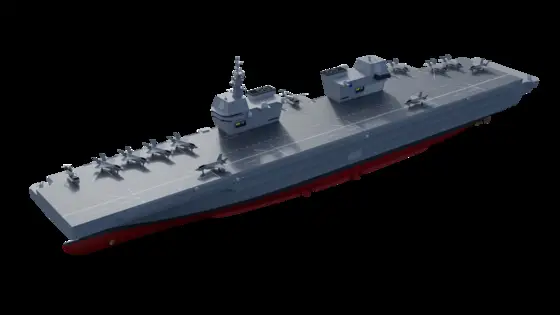On November 8, ahead of Navy Week, the Navy’s 76th anniversary this year, the South Korean Navy released a video of a light aircraft carrier for the first time.
The 6-minute video features all aspects that make up the light carrier combat group, from the departure of the light carrier, operations of vertical take-off and landing fighters, the attack on target attack and the advancing of the battle group, etc.
In the video, the light carrier is accompanied by an Aegis destroyer (DDG), a new logistics support ship (AOE-II), a medium-sized submarine (SS-III), and the next-generation destroyer (KDDX) that are currently in operation in the Navy, as well as an air controller (E-737).
South Korea aims to complete the building of the light carrier by 2033.
South Korea’s light aircraft carrier
The stealthy 30,000-ton carrier features a flat deck similar to a US Carrier and has no ski jump. The British Carrier Queen Elizabeth operates F-35 B fighter aircraft but features a ski jump. The ship has two islands or bridges like the British Carrier. One bridge is in charge of navigation, and the other is in charge of air traffic control. If one bridge is hit, the other bridge can operate the complete operations of the ship.
There are two elevators on the starboard to lift the aircraft from the hangar to the deck, making the deck a bit wider but vulnerable to enemy attack.

The carrier can move faster as it does not feature a well dock, a space where the landing craft or amphibious armoured vehicle can be floated by opening the door during the amphibious operation.
The Korean designers have taken inspiration from the Italian Cavour (550) while designing the light carrier. The 30,000-ton Cavour is equipped with 10 AV-8B Harrier II fighters. In May of last year, modifications were completed to carry the F-35B. The South Korean carrier appears to be a bit larger and take more planes compared to Cavour. The Korean Carrier will be capable of operating 16 F-35B fighters as well as eight helicopters. It will also feature a high degree of automation and have a complement of 440 crew, not including the air element.
The light carrier does not have an early warning helicopter. Instead, the destroyers are placed at the forefront of carrier squadrons, or fighters are constantly on the move and sent to patrol operations. The Italian Cavour does the same.
The light carrier is planned to be installed with the Multifunctional Phased Array (AESA) radar of the Korean next-generation destroyer (KDDX). The radar is powerful enough to track ballistic missiles.
For self-defence, the Navy’s light carrier is to equipped with a close-up defense system (CIWS) and an air-to-air missile defense guided weapon (SAAM). Korea has decided to develop the CIWS on their own. SAAM is Haegung, a surface-to-air missile produced by LIG Nex1. Haegung is a Korean vertical launch system (VLS). The missile is capable of intercepting a sea-skimming missile that flies low as if it glides across the surface of the water.
The estimated cost for the planned light aircraft carrier is US$1.68 billion, according to the South Korean Navy.
